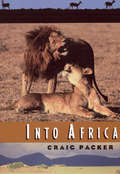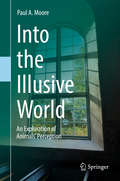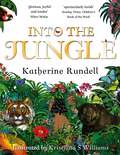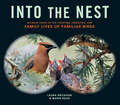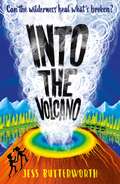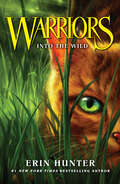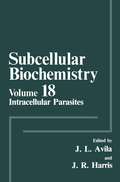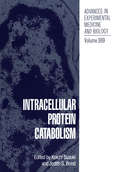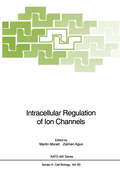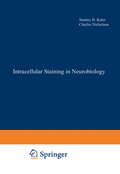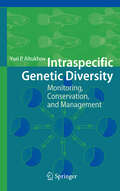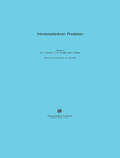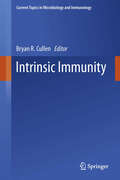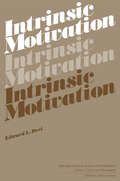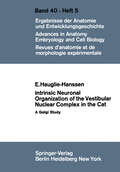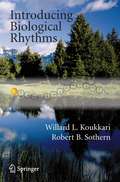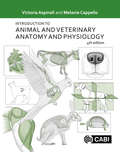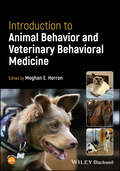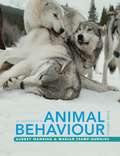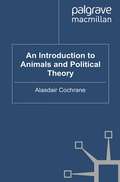- Table View
- List View
Into Africa
by Craig PackerCraig Packer takes us into Africa for a journey of fifty-two days in the fall of 1991. But this is more than a tour of magnificent animals in an exotic, faraway place. A field biologist since 1972, Packer began his work studying primates at Gombe and then the lions of the Serengeti and the Ngorongoro Crater with his wife and colleague Anne Pusey. Here, he introduces us to the real world of fieldwork—initiating assistants to lion research in the Serengeti, helping a doctoral student collect data, collaborating with Jane Goodall on primate research. As in the works of George Schaller and Cynthia Moss, Packer transports us to life in the field. He is addicted to this land—to the beauty of a male lion striding across the Serengeti plains, to the calls of a baboon troop through the rain forests of Gombe—and to understanding the animals that inhabit it. Through his vivid narration, we feel the dust and the bumps of the Arusha Road, smell the rosemary in the air at lunchtime on a Serengeti verandah, and hear the lyrics of the Grateful Dead playing off bootlegged tapes. Into Africa also explores the social lives of the animals and the threats to their survival. Packer grapples with questions he has passionately tried to answer for more than two decades. Why do female lions raise their young in crèches? Why do male baboons move from troop to troop while male chimps band together? How can humans and animals continue to coexist in a world of diminishing resources? Immediate demands—logistical nightmares, political upheavals, physical exhaustion—yield to the larger inescapable issues of the interdependence of the land, the animals, and the people who inhabit it.
Into Africa
by Craig PackerCraig Packer takes us into Africa for a journey of fifty-two days in the fall of 1991. But this is more than a tour of magnificent animals in an exotic, faraway place. A field biologist since 1972, Packer began his work studying primates at Gombe and then the lions of the Serengeti and the Ngorongoro Crater with his wife and colleague Anne Pusey. Here, he introduces us to the real world of fieldwork—initiating assistants to lion research in the Serengeti, helping a doctoral student collect data, collaborating with Jane Goodall on primate research. As in the works of George Schaller and Cynthia Moss, Packer transports us to life in the field. He is addicted to this land—to the beauty of a male lion striding across the Serengeti plains, to the calls of a baboon troop through the rain forests of Gombe—and to understanding the animals that inhabit it. Through his vivid narration, we feel the dust and the bumps of the Arusha Road, smell the rosemary in the air at lunchtime on a Serengeti verandah, and hear the lyrics of the Grateful Dead playing off bootlegged tapes. Into Africa also explores the social lives of the animals and the threats to their survival. Packer grapples with questions he has passionately tried to answer for more than two decades. Why do female lions raise their young in crèches? Why do male baboons move from troop to troop while male chimps band together? How can humans and animals continue to coexist in a world of diminishing resources? Immediate demands—logistical nightmares, political upheavals, physical exhaustion—yield to the larger inescapable issues of the interdependence of the land, the animals, and the people who inhabit it.
Into Africa
by Craig PackerCraig Packer takes us into Africa for a journey of fifty-two days in the fall of 1991. But this is more than a tour of magnificent animals in an exotic, faraway place. A field biologist since 1972, Packer began his work studying primates at Gombe and then the lions of the Serengeti and the Ngorongoro Crater with his wife and colleague Anne Pusey. Here, he introduces us to the real world of fieldwork—initiating assistants to lion research in the Serengeti, helping a doctoral student collect data, collaborating with Jane Goodall on primate research. As in the works of George Schaller and Cynthia Moss, Packer transports us to life in the field. He is addicted to this land—to the beauty of a male lion striding across the Serengeti plains, to the calls of a baboon troop through the rain forests of Gombe—and to understanding the animals that inhabit it. Through his vivid narration, we feel the dust and the bumps of the Arusha Road, smell the rosemary in the air at lunchtime on a Serengeti verandah, and hear the lyrics of the Grateful Dead playing off bootlegged tapes. Into Africa also explores the social lives of the animals and the threats to their survival. Packer grapples with questions he has passionately tried to answer for more than two decades. Why do female lions raise their young in crèches? Why do male baboons move from troop to troop while male chimps band together? How can humans and animals continue to coexist in a world of diminishing resources? Immediate demands—logistical nightmares, political upheavals, physical exhaustion—yield to the larger inescapable issues of the interdependence of the land, the animals, and the people who inhabit it.
Into Africa
by Craig PackerCraig Packer takes us into Africa for a journey of fifty-two days in the fall of 1991. But this is more than a tour of magnificent animals in an exotic, faraway place. A field biologist since 1972, Packer began his work studying primates at Gombe and then the lions of the Serengeti and the Ngorongoro Crater with his wife and colleague Anne Pusey. Here, he introduces us to the real world of fieldwork—initiating assistants to lion research in the Serengeti, helping a doctoral student collect data, collaborating with Jane Goodall on primate research. As in the works of George Schaller and Cynthia Moss, Packer transports us to life in the field. He is addicted to this land—to the beauty of a male lion striding across the Serengeti plains, to the calls of a baboon troop through the rain forests of Gombe—and to understanding the animals that inhabit it. Through his vivid narration, we feel the dust and the bumps of the Arusha Road, smell the rosemary in the air at lunchtime on a Serengeti verandah, and hear the lyrics of the Grateful Dead playing off bootlegged tapes. Into Africa also explores the social lives of the animals and the threats to their survival. Packer grapples with questions he has passionately tried to answer for more than two decades. Why do female lions raise their young in crèches? Why do male baboons move from troop to troop while male chimps band together? How can humans and animals continue to coexist in a world of diminishing resources? Immediate demands—logistical nightmares, political upheavals, physical exhaustion—yield to the larger inescapable issues of the interdependence of the land, the animals, and the people who inhabit it.
Into the Illusive World: An Exploration of Animals’ Perception
by Paul A. MooreHave you ever thought about what a dog smells as it stops to sniff at a tree? Or what a cat is watching as it stares intensely off into space? What about animals in the wild? What do they see, hear, smell, and feel? How do they perceive their surroundings? This is the illusive world. A world filled with fascinating stimuli that we are not equipped to detect. This is particularly true because we tend to rely so heavily on our eyes or ears. We are figuratively, and literally, blind to this part of the natural world. This part, which is full of stimuli we cannot perceive, encompasses the daily lives of so many animals. Beneath our feet are ants, moles, and spiders using vibrations to coordinate colonies and communicate danger. In the oceans, turtles, fish, and octopi are sensitive to magnetic and electric fields, as well as tasty morsels at the tips of their tentacles. In the skies, owls and raptors can see deep into a lake or pierce the night with highly sensitive eyes. This book brings together all these animals and their amazing sensory abilities in an exploration of how animals perceive their world. Within these pages are wonderful and exciting stories of organisms using their senses to perform sophisticated communication with nestmates, find hidden prey in the dark of night or murky of depths, and call to lovers both near and far. This book will open the door to this illusive world and will take you on a journey into the illusive world and see how different the world is when perceived through another animal’s senses.
Into the Jungle
by Katherine Rundell'Rundell's interpretation is glorious.' Kiran Millwood HargraveInto the Jungle is a modern classic in the making, as Katherine Rundell creates charming and compelling origin stories for all Kipling's best-loved characters, from Baloo and Shere Khan to Kaa and Bagheera. As Mowgli travels through the Indian jungle, this brilliantly visual tale, which weaves each short story together into a wider whole, will make readers both laugh and cry.Rudyard Kipling's The Jungle Book, first published by Macmillan in 1894, is one of the most enduring books of children's literature, delighting generations of children. Katherine Rundell has taken this as the basis of her new and enchanting tale, sharing the early years of favourite characters and informing the creatures they become in Kipling's classic, with stories about family and friendship, loyalty and jungle law, and a final battle which will decide the future of the forest.A gorgeously produced paperback with a foiled cover and colour illustrations throughout by creative genius Kristjana S Williams, this is truly a book for all the family to treasure and share.
Into the Nest: Intimate Views of the Courting, Parenting, and Family Lives of Familiar Birds
by Laura Erickson Marie ReadDocumentary photography and intriguing facts provide a close encounter with the domestic lives of North American birds found in backyards, city neighborhoods, forests, fields, and waterways, from first flirtation to the final fledgling&’s departure from the nest.
Into the Volcano
by Jess ButterworthFrom Jess Butterworth comes another beautifully written adventure set on top of a super volcano, about coming to terms with grief, letting go of anger at the world and finding hope and joy in the most unexpected of places.Vivi and Seb live halfway across the world from each other, living completely separate lives, until a terrible event unexpectedly makes their paths collide. Seb's best friend Clay was injured in a shooting, and Seb believes there's a rainbow pool in the heart of Yellowstone National Park that will help heal him heal. Meanwhile, Vivi is feeling lost, wishing she could find a way to honour her grandmother, who didn't survive the same shooting.When they meet at the memorial and Seb tells Vivi what he wants to do, Vivi is convinced that her grandmother would have wanted her to go with Seb to help his friend.But the park is filled with dangerous creatures, and when Seb is injured in one of the volcanic springs, it becomes a race for survival as they try and make their wish and find their way out of the wilderness.Told through multiple viewpoints and set between the US and the UK, this is another heartfelt middle grade adventure from award-winning author Jess Butterworth
Into the Wild (Warriors #1)
by Erin HunterTake your first steps into the wilderness with Rusty the house cat as he leaves his home to go and live in the wild. A thrillling new feline fantasy series that draws you into a vivid animal world.
Intracellular Parasites (Subcellular Biochemistry #18)
by José-Luis Avila J. Robin HarrisVolume 18 of the Subcellular Biochemistry series, which specializes in various aspects of the biochemistry of the intracellular parasites, was initially proposed by Jose Luis Avila and strongly supported by myself, as Series Editor of Sub cellular Biochemistry. Considerable assistance was received from Professor Frank Wunderlich (University of Dusseldorf) and more particularly from Dr. Michael Miles (London School of Hygiene and Tropical Medicine) during the compilation of the list of possible chapters. Our initial aim was to present a comprehensive survey of this broad field of study. Although some interesting topics have been lost due to authors backing out late in the production schedule of the book, the manuscripts that were submitted have provided a useful over view of the subject, with notable strength within the field of Leishmania. The 13 chapters of the book have been grouped according to subject. The first five chapters deal with Leishmania and are followed by two chapters on Try ponosoma cruzi, two on the malarial parasites, and two on the Coccidia. The fmal two chapters cover the Microsporidia and chemotherapy, respectively.
Intracellular Protein Catabolism (Advances in Experimental Medicine and Biology #389)
by Koichi Suzuki Judith S. BondThe Tenth International Conference on Intracellular Protein Catabolism was held in Tokyo Japan, October 30-November 3, 1994. under the auspices of the International Committee on Proteolysis (lCOP). ICOP meetings have been held biennially in the USA, Europe, and Japan in turn. The previous three ICOP meetings (7th to 9th) were held in Shimoda, Japan, in 1988. in WildbadKreuth, Germany, in 1990, and in Williamsburg. Virginia, in 1992. Previous meetings were held in resort areas, this was the first meeting held in a large city. Attendance has grown every year so that nearly 400 participants from 19 different countries attended the Tokyo meeting. At the meeting, novel and updated results on the structure-function. physiology, biology, and pathology of proteases and inhibitors were discussed, together with cellular aspects of proteolysis and protein turnover. Thirty-nine invited papers and eight selected posters were presented orally and 171 poster presentations were discussed. This book documents almost all of the lectures and some selected posters. Since the world of proteolysis and protein turnover is expanding very rapidly. far beyond our expectations, it is impossible to cover all the new aspects of this field. However, this book will give an idea of the current status, trends. and directions of the field, and information necessary to understand what is and will be important in this field. Further. the editors hope that the novel ideas, approaches. methodologies, and important findings described in this book will stimulate further study on proteolysis and protein turnover.
Intracellular Regulation of Ion Channels (Nato ASI Subseries H: #60)
by Martin Morad Zalman AgusUnderstanding the molecular processes by which ionic channels are regulated is central to the understanding of cellular function. Great advances in understanding these regulatory mechanisms have been recently achieved by the combination of several powerful techniques. Development of the patch clamp technique, ability to access the intracellular channels sites, and genetic manipulation of channel structure have allowed studies of channel function in native membranes. Cloning, sequencing and determining the channel structure and its subunits allows further insight into the regulatory mechanisms of channel function. In planning this symposium, we organized the scientific discussions around specific molecular topics independent of the tissue and species of origin. Clearly, the subject of ion channel regulation is multi-faceted, with a large number of very talented scientists working in the field. The NATO Symposium represented an attempt to bring together these individuals and synthesize and evaluate new ideas and experimental findings. A great deal of novel data was presented, and scientific insight into the molecular processes which regulate ionic channels was furthered. This book gives a synopsis of the scientific presentations and is organized into 3 sections. The first section deals with the diversity of K + channels and their regulation, including structure-function and mechanistic studies. Presentations dealt with the characterization and modulation of a variety ofK+ channels in cardiac and neuronal cells, including ATP dependent K+ channels, Na + -activated K+ channels, delayed rectifier K+ channels and the diversity of their regulation by G-proteins.
Intracellular Staining in Neurobiology
by Stanley B. Kater Charles NicholsonThe purpose of this book is to provide basic reference material to facilitate the further development and application of the intracellular staining techniques which originated with the introduction of Procion dye as a neurocellular stain. We had sev eral specific objectives in compiling these chapters. First, we recognized that both the techniques and results of intracellular staining have been derived from a variety of preparations and published in diverse journals. Consequently, we tried to make this information more readily available by incorporating several reviews by original authors. This should provide the reader with a knowledge of the kinds of neurobiological prob lems for which intracellular staining has already been employed. A second objective was to facilitate extension of these methods to a wider variety of problems. To this end there are chapters dealing with Procion dye as a marker for ultrastructural investi gations, the use of cobalt as a staining compound and the implementation of computer techniques for quantitative studies of neuronal relationships. As background for further extension of these methods this volume contains material on the history of the discovery of Procion dyes as intracellular stains, the chemistry of these dyes, and fundamentals of fluorescence microscopy. Our final specific objective was to present details of technical procedures that were not readily available in the literature.
Intraspecific Genetic Diversity: Monitoring, Conservation, and Management
by Yuri Petrovich AltukhovPopulation and evolutionary genetics have been quickly developing ?elds of biological research over the past decades. This book compiles our current understanding of genetic processes in natural populations. In addition, the book provides the author’s original ideas and concepts based on the data obtained by himself and his close coworkers. The author introduces his pioneering concept of population genetic stability,and much of thebook is concerned with the factors and conditions of such stability. Why does genetic stability matter so much? Altukhov argues that the sustainable use of natural resources, including genetic resources of popu- tions, critically depends on the maintenance of their stability. The preser- tion of well-adapted genetic characteristics from one generation to the next is essential for this stability. Traditionally, population genetics has been - cusedonevolution andthe role of evolutionary factorsinshapinggenetic structures of populations. While the idea of a population as a dynamic unit of evolution has been widely accepted, the signi?cance of genetic stability and its implications for the long-term survival of populations and species have not been fully appreciated.
Intrazooplankton Predation (Developments in Hydrobiology #60)
by Henri J. Dumont J. G. Tundisi K. RocheIntrinsic Immunity (Current Topics in Microbiology and Immunology #371)
by Bryan R. CullenRecent research has focused attention on the importance of intrinsic antiviral immunity, i.e. immunity mediated by factors that are constitutively expressed in many cells. In this volume, leading experts provide a comprehensive overview of this relatively new and rapidly evolving field. They cover intrinsic proteinaceous antiviral immune effectors, such as the APOBEC3 and TRIM protein families as well as Tetherin and SAMHD1, which were initially discovered by researchers studying HIV-1. Furthermore, the role of RNA interference in antiviral defense in plants and invertebrates, as well as the interplay between microRNAs and viruses in mammalian cells, are analysed. One chapter discusses how intrinsic immunity and viral countermeasures to intrinsic immune effectors drive both pathogen and host evolution, and finally the emerging evidence that DNA damage response proteins restrict infection by DNA viruses is highlighted.
Intrinsic Motivation (Perspectives in Social Psychology)
by Edward L. DeciAs I begin to write this Preface, I feel a rush of excitement. I have now finished the book; my gestalt is coming into completion. Throughout the months that I have been writing this, I have, indeed, been intrinsically motivated. Now that it is finished I feel quite competent and self-determining (see Chapter 2). Whether or not those who read the book will perceive me that way is also a concern of mine (an extrinsic one), but it is a wholly separate issue from the intrinsic rewards I have been experiencing. This book presents a theoretical perspective. It reviews an enormous amount of research which establishes unequivocally that intrinsic motivation exists. Also considered herein are various approaches to the conceptualizing of intrinsic motivation. The book concentrates on the approach which has developed out of the work of Robert White (1959), namely, that intrinsically motivated behaviors are ones which a person engages in so that he may feel competent and self-determining in relation to his environment. The book then considers the development of intrinsic motiva tion, how behaviors are motivated intrinsically, how they relate to and how intrinsic motivation is extrinsically motivated behaviors, affected by extrinsic rewards and controls. It also considers how changes in intrinsic motivation relate to changes in attitudes, how people attribute motivation to each other, how the attribution process is motivated, and how the process of perceiving motivation (and other internal states) in oneself relates to perceiving them in others.
Intrinsic Neuronal Organization of the Vestibular Nuclear Complex in the Cat: A Golgi Study (Advances in Anatomy, Embryology and Cell Biology #40/5)
by E. Hauglie-HanssenIntroducing Biological Rhythms: A Primer on the Temporal Organization of Life, with Implications for Health, Society, Reproduction, and the Natural Environment
by Willard L. Koukkari Robert B. SothernIntroducing Biological Rhythms is a primer that serves to introduce individuals to the area of biological rhythms. It describes the major characteristics and discusses the implications and applications of these rhythms, while citing scientific results and references. Also, the primer includes essays that provide in-depth historic and other background information for those interested in more specific topics or concepts. It covers a basic cross-section of the field of chronobiology clearly enough so that it can be understood by a novice, or an undergraduate student, but that it would also be sufficiently technical and detailed for the scientist.
Introduction to Animal and Veterinary Anatomy and Physiology
by Victoria Aspinall BVSc, MRCVS Melanie Cappello BSc (Hons) ZooloA sound knowledge of anatomy and physiology is an essential basis for the effective clinical treatment of companion animals and farm animals alike. The fourth edition of this bestselling book continues to provide a comprehensive description of the anatomy and physiology of dogs and cats. The book builds on these foundations with detailed descriptions of exotic small species including birds, and domestic farm animals, including cows, sheep and pigs, as well as the horse. The text: Contains detailed descriptions of the systematic anatomy and physiology of a wide range of animal species. Covers clinical conditions and disease examples related to the individual body systems. Includes applied anatomy tips that relate theory to clinical practice. Is written by expert authors with a wealth of veterinary, animal science and teaching experience. Includes more clinical application examples and question and answer tests to reinforce student learning. Has been updated with more information for animal science students. This text provides an essential basis for all those embarking upon a veterinary, animal science or animal management career.
Introduction to Animal Behavior and Veterinary Behavioral Medicine
by Meghan E. HerronIntroduction to Animal Behavior and Veterinary Behavioral Medicine Understand and apply key concepts of animal behavior in veterinary practice Animal behavior is a critical aspect of veterinary medicine, often underappreciated despite its pervasiveness throughout the field. Understanding animal behavior can facilitate communication with patients, refine diagnoses and indications of ill health, and aid in processes of learning and socialization. Introduction to Animal Behavior and Veterinary Behavioral Medicine offers a comprehensive overview of the key concepts underlying the behavior of multiple animal species before demonstrating how to apply these concepts clinically. The result is an indispensable resource for veterinary students and practitioners who want to deepen their understanding of patient needs. Introduction to Animal Behavior and Veterinary Behavioral Medicine readers will also find: Comprehensive coverage of companion animal behavior and additional coverage of livestock and wild animal behavior Detailed discussion of topics including social development, animal learning, and applied behavior analysis In depth review of diagnosis and treatment strategies for common behavior disorders in companion animals, extending to various additional species Companion website with videos, handouts for downloading, and links to pertinent scientific articles and informative websites Introduction to Animal Behavior and Veterinary Behavioral Medicine is ideal preparation for veterinary medical students as part of “day one readiness” in their professional careers, as well as veterinary practitioners looking for a solid foundation in animal behavior and the treatment of key issues.
Introduction to Animal Behavior and Veterinary Behavioral Medicine
by Meghan E. HerronIntroduction to Animal Behavior and Veterinary Behavioral Medicine Understand and apply key concepts of animal behavior in veterinary practice Animal behavior is a critical aspect of veterinary medicine, often underappreciated despite its pervasiveness throughout the field. Understanding animal behavior can facilitate communication with patients, refine diagnoses and indications of ill health, and aid in processes of learning and socialization. Introduction to Animal Behavior and Veterinary Behavioral Medicine offers a comprehensive overview of the key concepts underlying the behavior of multiple animal species before demonstrating how to apply these concepts clinically. The result is an indispensable resource for veterinary students and practitioners who want to deepen their understanding of patient needs. Introduction to Animal Behavior and Veterinary Behavioral Medicine readers will also find: Comprehensive coverage of companion animal behavior and additional coverage of livestock and wild animal behavior Detailed discussion of topics including social development, animal learning, and applied behavior analysis In depth review of diagnosis and treatment strategies for common behavior disorders in companion animals, extending to various additional species Companion website with videos, handouts for downloading, and links to pertinent scientific articles and informative websites Introduction to Animal Behavior and Veterinary Behavioral Medicine is ideal preparation for veterinary medical students as part of “day one readiness” in their professional careers, as well as veterinary practitioners looking for a solid foundation in animal behavior and the treatment of key issues.
An Introduction To Animal Behaviour (400MB+ File Request)
by Aubrey Manning Marian Stamp Dawkins400MB+ File Request. Wolves excitedly greet each other as members of the pack come together; a bumble bee uses its long tongue to reach the nectar at the base of a foxglove flower; a mongoose swiftly and deftly bites its prey to death; young cheetahs rest quietly together, very close to sleep. Now in full colour, this revised and updated edition of Manning and Dawkins' classic text provides a beautifully written introduction to the fundamentals of animal behaviour. Tinbergen's four questions of causation, evolution, development and function form the fundamental framework of the text, illustrated with fascinating examples of complex behavioural mechanisms. The authors provide accounts of all levels of behaviour from the nerve cell to that of the population. The strengths of An Introduction to Animal Behaviour as a textbook include its clear explanations and concise, readable text and the enthusiasm of the authors for their subject.
An Introduction To Animals And Political Theory (The\palgrave Macmillan Animal Ethics Ser. )
by Alasdair CochraneStructured around the five most important schools within contemporary political theory: liberalism, utilitarianism, communitarianism, Marxism and feminism, this is the first introductory level text to offer an accessible overview on the status of animals in contemporary political theory.
An Introduction To Animals And Political Theory (The\palgrave Macmillan Animal Ethics Ser. )
by Alasdair CochraneStructured around the five most important schools within contemporary political theory: liberalism, utilitarianism, communitarianism, Marxism and feminism, this is the first introductory level text to offer an accessible overview on the status of animals in contemporary political theory.
